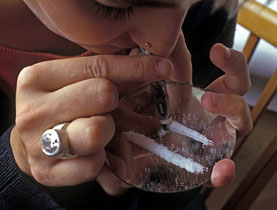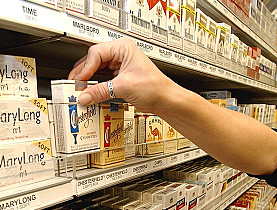Cheaper cocaine entices younger generation

Cocaine, the pick-me-up drug of the in-crowd, is gaining popularity among younger age groups in Switzerland.
The reasons are a fall in the street price and cocaine’s enduring if questionable reputation as a performance enhancing and energising drug.
There are no exact figures on the extent of cocaine use but clear indications of an increase in consumption come from the experience of drug experts and the amount of cocaine seized by the authorities.
The amount of confiscated cocaine has more than doubled according to Swiss crime statistics. The Federal Police Office assumes that imports have increased by the same amount.
However, the figures on seizure of Ecstacy tend to suggest a decrease in imports of that drug.
For cocaine there are large amounts involved, a wide variety of distribution channels and street prices that have come down massively.
“Consumption of cocaine has become possible for wider and younger sections of society,” Ueli Spörri, head of the Association for Risk Reduction in Use of Drugs in Zurich, told swissinfo.
In the 1980s a gram of cocaine cost between SFr500 ($475.5) and SFr600, depending on its purity. Today it costs between SFr40 and SFr120, which is as little as SFr8 a line.
Cinema trip
“A cocaine evening is about as expensive for youngsters as a trip to the cinema,” noted Urs Rohr from the Centre for the Prevention of Drug Addiction in Zurich. The drug does not have a long-lasting effect and so parents in most cases do not notice that their children have been consuming cocaine, he added.
“Many youngsters snort it at a party or with friends and many come off the trial phase. A short, reasonably-controlled period of consumption leaves hardly any damage,” Spörri said.
But the fact remains that cocaine is a strong drug. “Longer and increasing use leads to physical problems. As a result, the drug should not be underestimated.”
Cocaine prevention is controversial among experts and is considered very difficult. As Spörri puts it, youngsters want to go out and enjoy themselves and not read brochures.
“We have little leeway but that is a general problem and is no different from tobacco prevention. What is forbidden is no less attractive, maybe even the opposite.”
In vogue
In addition, cocaine is in keeping with the times. Heroin has the aura of a loser’s drug. Cocaine is considered the drug of the beautiful and successful. Its effects can include loss of inhibitions and euphoria although side effects are unpredictable.
“In your professional life high stability and a willingness to perform are required. Cocaine can help,” Spörri said. Most consumers can manage to reconcile their working life and cocaine consumption over years.
According to estimates, between only eight and ten per cent sink into heavy dependence. “Physical dependence takes considerably longer than with heroin,” commented Irene Caspar, medical director of the Poliklinik DBB in Horgen.
“Many cocaine consumers are weekend users and lead an active working life.”
The majority of patients being treated in Horgen for cocaine dependence are over 40 and have been consuming cocaine for decades.
Downward spiral
In many cases cocaine consumption leads to a downward spiral of dependence on medication and relationship or money problems.
Irrespective of age there are many reasons that lead people to seek treatment, Caspar said. Therefore therapy has to be tailored to the individual. The focus is more on psychotherapy than on medication.
In many cases, patients want complete abstinence, Caspar said, but much more promising were joint goals for a partial withdrawal.
She added that in principle it was important that help was on offer early enough. Many come voluntarily. “They are motivated more than those who come to us through relatives or the social services.
In recent years, the number of patients in the relatively rural Horgen has increased. In the city Zurich, the increase is somewhat larger, but not dramatic when compared with the problem of alcohol.
Caspar puts into perspective media reports that all the country’s youth are addicted to the white powder: “Only a small proportion of youngsters snort cocaine,” she said.
swissinfo, based on an article in German by Andreas Keiser
Cocaine has a high potential for causing addiction.
Consumption of a mixture of cocaine and other drugs increases health problems, particularly cardiovascular circulation.
Consumption of cocaine can in the short-term trigger hallucinations.
Long-term consumption can increase the risk of longer-lasting psychotic conditions.
Consumption can lead to overestimation of one’s own capabilities.
In pregnant women cocaine increases the risk of premature labour.

In compliance with the JTI standards
More: SWI swissinfo.ch certified by the Journalism Trust Initiative











You can find an overview of ongoing debates with our journalists here . Please join us!
If you want to start a conversation about a topic raised in this article or want to report factual errors, email us at english@swissinfo.ch.